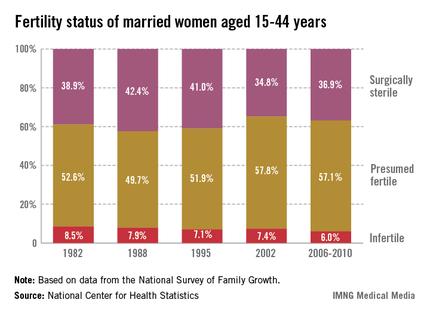Recent trends in fertility problems in the United States include a drop in the proportion of married women aged 15-44 who were infertile from 8.5% in 1982 to 6% between 2006 and 2010, according to a report from the National Center for Health Statistics.
The corresponding number of women affected dropped from 2.4 million in 1982 to 1.5 million in the later period.
Among all the women surveyed, the proportion of women with impaired fecundity stabilized at 11% in 2006-2010. Prior to this period, the proportion had increased significantly from 8.4% in 1982 to 10% in 1995 and 12% in 2002. There was a similar pattern observed among married women, although the proportion affected was higher: In 1982 and 1988, 11% of married women had impaired fecundity, increasing to 15% in 2002 and dropping to 12% in 2006-2010, according to Anjanai Chandra, Ph.D., of the NCHS, and her coauthors.
The data are from the National Survey of Family Growth (NSFG), which provides nationally representative measures of fertility, based on 22,682 interviews with men and women aged 15-44, from June 2006 through June 2010. The report was published on Aug. 14 (Natl. Health Stat. Report. 2013;67:1-19). Data are also collected for men: Between 2006 and 2010, 9.4% of men aged 15-44 and 12% of men aged 25-44 reported having some form of infertility, which was similar to the proportion reported in 2002, when men were first included in the survey,
In women, the two infertility measures used since 1982 are infertility (defined as "a lack of pregnancy in the 12 months prior to the survey, despite having unprotected sexual intercourse in each of those months with the same husband or partner") and impaired fecundity ("physical difficulty in either getting pregnant or carrying a pregnancy to live birth"). The infertility measure has been limited to couples who are married or living together, because it does not distinguish between infertility in the male or female partner. Because of issues with the size of the sample, the authors reported infertility estimates in subgroups in married women only, but noted that in 2006-2010, the proportions of married and cohabiting women who were infertile were similar, at 6% and 4.9%, respectively.
The authors pointed out that among nulliparous women, infertility and impaired fecundity were closely associated with age: Among married nulliparous women aged 35-44, the proportion who were infertile dropped from 44% in 1982 to 27% in 2006-2010.
They also compared some data to data from the National Fertility Study in 1965: Among married women who were infertile, the rate of primary infertility – the proportion who were having problems having their first child – increased from 17% in 1965 to 41%-46% in 1982-2010, "which is consistent with patterns and trends in delayed childbearing over these years," the authors pointed out.
While there was no "clear association" between poverty level and education, women who were less educated and at poverty income levels were more likely to be surgically sterilized. For example, between 2006 and 2010, among women aged 25-44 years, 44% of those who had not completed high school had undergone surgical sterilization for contraceptive reasons, compared with 21% of those with a bachelor’s degree and 16% of those with a master’s degree or higher degree. The women with more education also were more likely to be fecund (65%-71%), compared with those with a high school education or less (42%-43%), "presumably because these latter women started and completed their fertility at younger ages and opted for surgical sterilization," the authors wrote.
The NSFG has been collecting data on impaired fecundity in all women aged *15-44 years since 1982 and 12-month infertility data in married women since 1973. The data provide "demographic ‘snapshots’ of the impact of societal trends such as delayed childbearing, and tracks the potential demand for infertility-related medical services," said Dr. Chandra and her associates.
There are no disclosures. The National Center for Health Statistics is part of the Centers for Disease Control and Prevention.
emechcatie@frontlinemedcom.com
*Correction (8/29/13): A previous version of this story misstated the age range of the women involved in the study. This version has been updated.


